Comprehensive Business Research Proposal: Cloud Computing System
VerifiedAdded on 2021/06/16
|21
|6334
|50
Project
AI Summary
This business research proposal explores the viability of cloud computing as a business venture. It begins with an introduction and project objectives, followed by a project scope and literature review defining cloud computing, its characteristics, and service models (SaaS, PaaS, IaaS). The proposal highlights the advantages of cloud computing, such as scalability and reduced costs, while also addressing challenges like security and data loss. The research questions focus on the advantages and challenges of cloud computing adoption. The methodology includes both qualitative and quantitative research approaches, detailing data collection methods, sampling, and analysis techniques. The proposal also considers research limitations and provides a timeline for completion, concluding with an assessment of cloud computing's potential as a business opportunity.
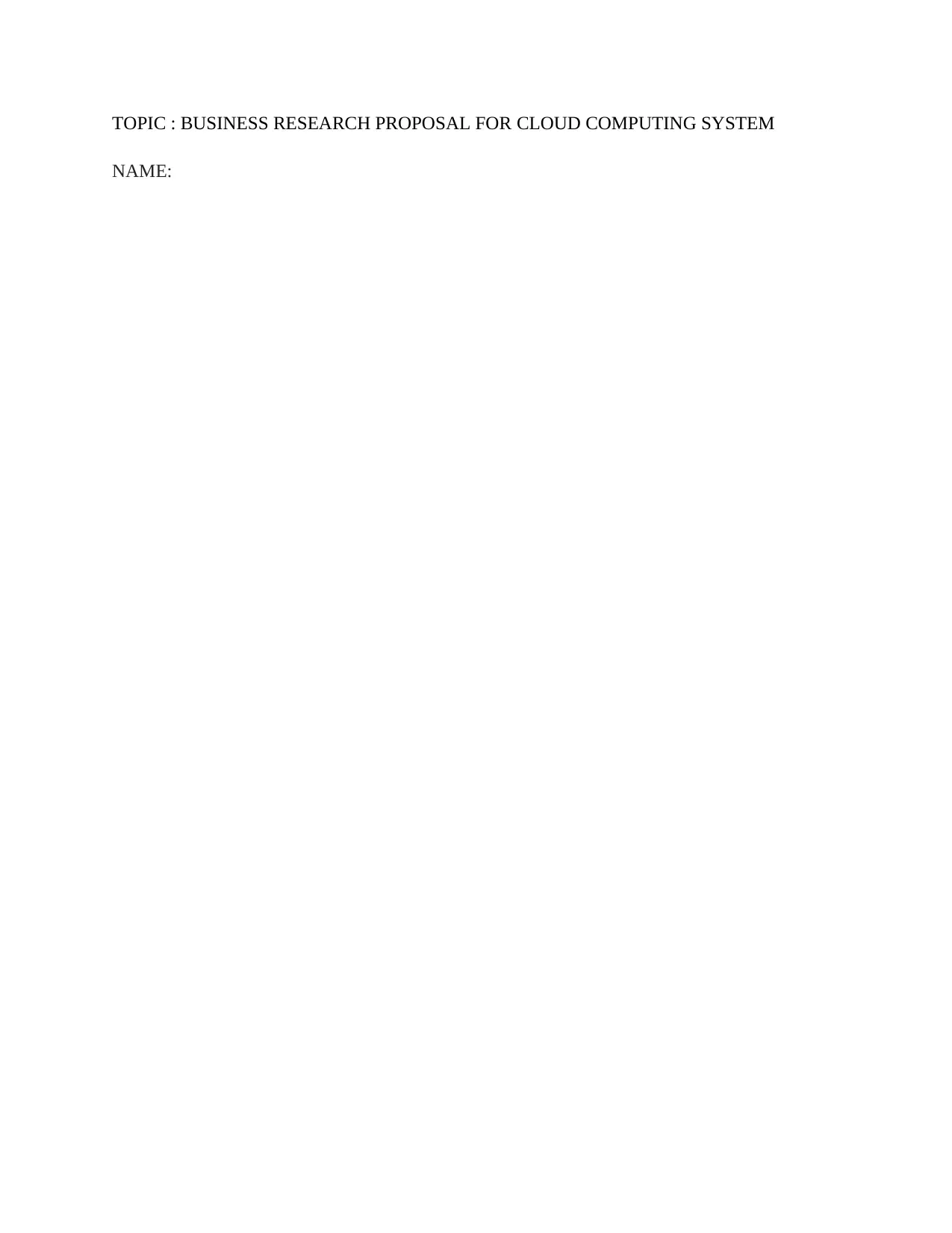
TOPIC : BUSINESS RESEARCH PROPOSAL FOR CLOUD COMPUTING SYSTEM
NAME:
NAME:
Paraphrase This Document
Need a fresh take? Get an instant paraphrase of this document with our AI Paraphraser
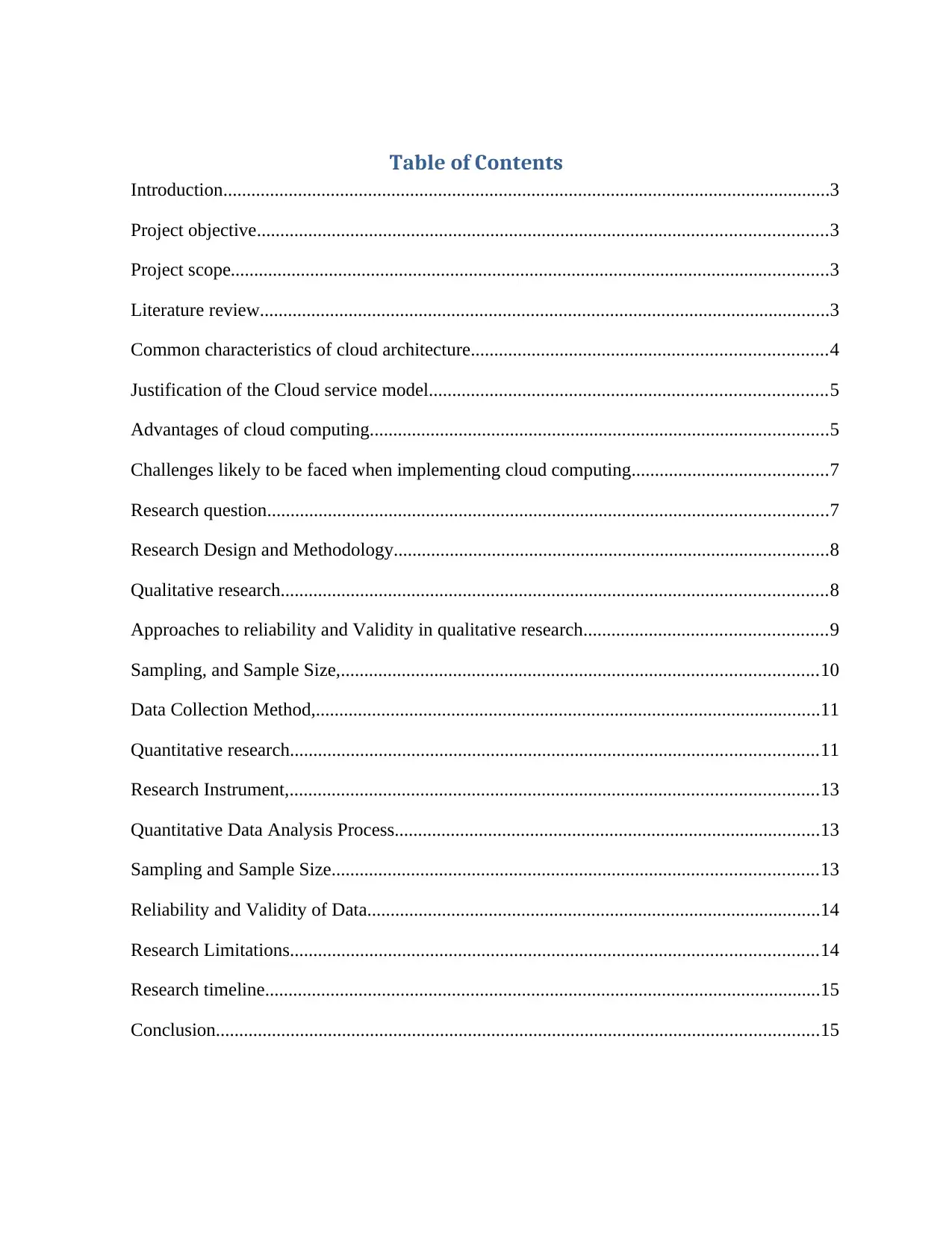
Table of Contents
Introduction..................................................................................................................................3
Project objective..........................................................................................................................3
Project scope................................................................................................................................3
Literature review..........................................................................................................................3
Common characteristics of cloud architecture............................................................................4
Justification of the Cloud service model.....................................................................................5
Advantages of cloud computing..................................................................................................5
Challenges likely to be faced when implementing cloud computing..........................................7
Research question........................................................................................................................7
Research Design and Methodology.............................................................................................8
Qualitative research.....................................................................................................................8
Approaches to reliability and Validity in qualitative research....................................................9
Sampling, and Sample Size,......................................................................................................10
Data Collection Method,............................................................................................................11
Quantitative research.................................................................................................................11
Research Instrument,.................................................................................................................13
Quantitative Data Analysis Process...........................................................................................13
Sampling and Sample Size........................................................................................................13
Reliability and Validity of Data.................................................................................................14
Research Limitations.................................................................................................................14
Research timeline.......................................................................................................................15
Conclusion.................................................................................................................................15
Introduction..................................................................................................................................3
Project objective..........................................................................................................................3
Project scope................................................................................................................................3
Literature review..........................................................................................................................3
Common characteristics of cloud architecture............................................................................4
Justification of the Cloud service model.....................................................................................5
Advantages of cloud computing..................................................................................................5
Challenges likely to be faced when implementing cloud computing..........................................7
Research question........................................................................................................................7
Research Design and Methodology.............................................................................................8
Qualitative research.....................................................................................................................8
Approaches to reliability and Validity in qualitative research....................................................9
Sampling, and Sample Size,......................................................................................................10
Data Collection Method,............................................................................................................11
Quantitative research.................................................................................................................11
Research Instrument,.................................................................................................................13
Quantitative Data Analysis Process...........................................................................................13
Sampling and Sample Size........................................................................................................13
Reliability and Validity of Data.................................................................................................14
Research Limitations.................................................................................................................14
Research timeline.......................................................................................................................15
Conclusion.................................................................................................................................15

⊘ This is a preview!⊘
Do you want full access?
Subscribe today to unlock all pages.

Trusted by 1+ million students worldwide
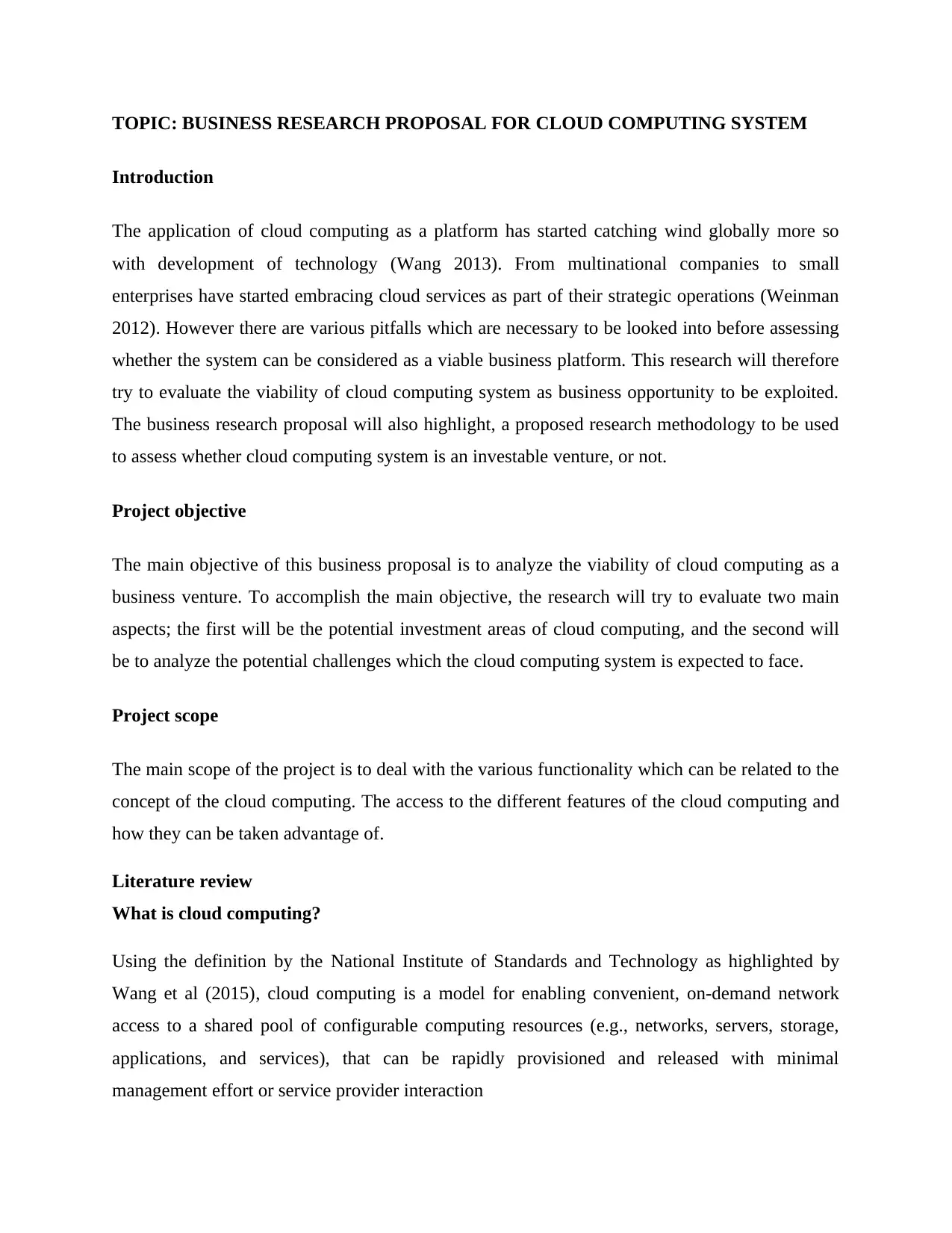
TOPIC: BUSINESS RESEARCH PROPOSAL FOR CLOUD COMPUTING SYSTEM
Introduction
The application of cloud computing as a platform has started catching wind globally more so
with development of technology (Wang 2013). From multinational companies to small
enterprises have started embracing cloud services as part of their strategic operations (Weinman
2012). However there are various pitfalls which are necessary to be looked into before assessing
whether the system can be considered as a viable business platform. This research will therefore
try to evaluate the viability of cloud computing system as business opportunity to be exploited.
The business research proposal will also highlight, a proposed research methodology to be used
to assess whether cloud computing system is an investable venture, or not.
Project objective
The main objective of this business proposal is to analyze the viability of cloud computing as a
business venture. To accomplish the main objective, the research will try to evaluate two main
aspects; the first will be the potential investment areas of cloud computing, and the second will
be to analyze the potential challenges which the cloud computing system is expected to face.
Project scope
The main scope of the project is to deal with the various functionality which can be related to the
concept of the cloud computing. The access to the different features of the cloud computing and
how they can be taken advantage of.
Literature review
What is cloud computing?
Using the definition by the National Institute of Standards and Technology as highlighted by
Wang et al (2015), cloud computing is a model for enabling convenient, on-demand network
access to a shared pool of configurable computing resources (e.g., networks, servers, storage,
applications, and services), that can be rapidly provisioned and released with minimal
management effort or service provider interaction
Introduction
The application of cloud computing as a platform has started catching wind globally more so
with development of technology (Wang 2013). From multinational companies to small
enterprises have started embracing cloud services as part of their strategic operations (Weinman
2012). However there are various pitfalls which are necessary to be looked into before assessing
whether the system can be considered as a viable business platform. This research will therefore
try to evaluate the viability of cloud computing system as business opportunity to be exploited.
The business research proposal will also highlight, a proposed research methodology to be used
to assess whether cloud computing system is an investable venture, or not.
Project objective
The main objective of this business proposal is to analyze the viability of cloud computing as a
business venture. To accomplish the main objective, the research will try to evaluate two main
aspects; the first will be the potential investment areas of cloud computing, and the second will
be to analyze the potential challenges which the cloud computing system is expected to face.
Project scope
The main scope of the project is to deal with the various functionality which can be related to the
concept of the cloud computing. The access to the different features of the cloud computing and
how they can be taken advantage of.
Literature review
What is cloud computing?
Using the definition by the National Institute of Standards and Technology as highlighted by
Wang et al (2015), cloud computing is a model for enabling convenient, on-demand network
access to a shared pool of configurable computing resources (e.g., networks, servers, storage,
applications, and services), that can be rapidly provisioned and released with minimal
management effort or service provider interaction
Paraphrase This Document
Need a fresh take? Get an instant paraphrase of this document with our AI Paraphraser
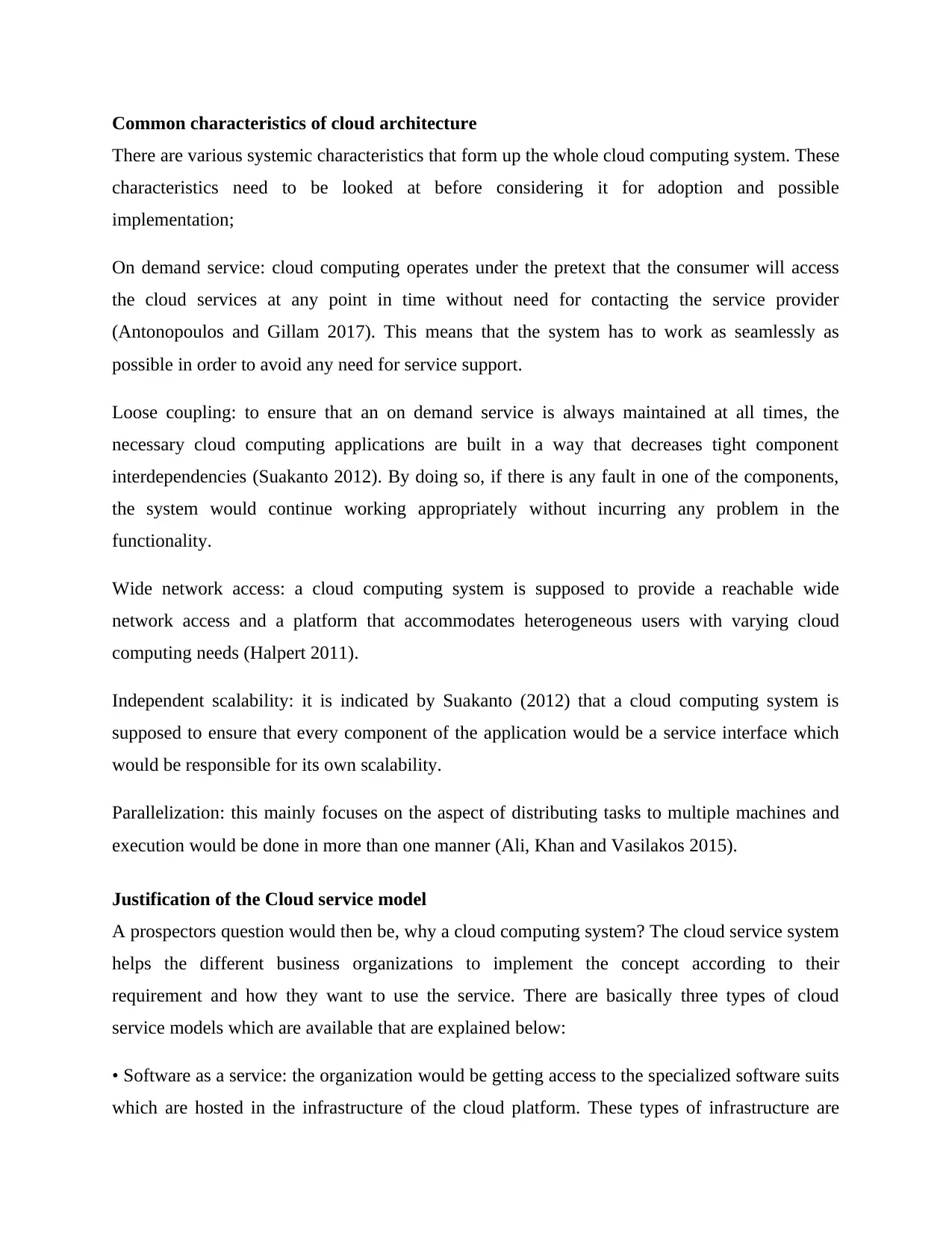
Common characteristics of cloud architecture
There are various systemic characteristics that form up the whole cloud computing system. These
characteristics need to be looked at before considering it for adoption and possible
implementation;
On demand service: cloud computing operates under the pretext that the consumer will access
the cloud services at any point in time without need for contacting the service provider
(Antonopoulos and Gillam 2017). This means that the system has to work as seamlessly as
possible in order to avoid any need for service support.
Loose coupling: to ensure that an on demand service is always maintained at all times, the
necessary cloud computing applications are built in a way that decreases tight component
interdependencies (Suakanto 2012). By doing so, if there is any fault in one of the components,
the system would continue working appropriately without incurring any problem in the
functionality.
Wide network access: a cloud computing system is supposed to provide a reachable wide
network access and a platform that accommodates heterogeneous users with varying cloud
computing needs (Halpert 2011).
Independent scalability: it is indicated by Suakanto (2012) that a cloud computing system is
supposed to ensure that every component of the application would be a service interface which
would be responsible for its own scalability.
Parallelization: this mainly focuses on the aspect of distributing tasks to multiple machines and
execution would be done in more than one manner (Ali, Khan and Vasilakos 2015).
Justification of the Cloud service model
A prospectors question would then be, why a cloud computing system? The cloud service system
helps the different business organizations to implement the concept according to their
requirement and how they want to use the service. There are basically three types of cloud
service models which are available that are explained below:
• Software as a service: the organization would be getting access to the specialized software suits
which are hosted in the infrastructure of the cloud platform. These types of infrastructure are
There are various systemic characteristics that form up the whole cloud computing system. These
characteristics need to be looked at before considering it for adoption and possible
implementation;
On demand service: cloud computing operates under the pretext that the consumer will access
the cloud services at any point in time without need for contacting the service provider
(Antonopoulos and Gillam 2017). This means that the system has to work as seamlessly as
possible in order to avoid any need for service support.
Loose coupling: to ensure that an on demand service is always maintained at all times, the
necessary cloud computing applications are built in a way that decreases tight component
interdependencies (Suakanto 2012). By doing so, if there is any fault in one of the components,
the system would continue working appropriately without incurring any problem in the
functionality.
Wide network access: a cloud computing system is supposed to provide a reachable wide
network access and a platform that accommodates heterogeneous users with varying cloud
computing needs (Halpert 2011).
Independent scalability: it is indicated by Suakanto (2012) that a cloud computing system is
supposed to ensure that every component of the application would be a service interface which
would be responsible for its own scalability.
Parallelization: this mainly focuses on the aspect of distributing tasks to multiple machines and
execution would be done in more than one manner (Ali, Khan and Vasilakos 2015).
Justification of the Cloud service model
A prospectors question would then be, why a cloud computing system? The cloud service system
helps the different business organizations to implement the concept according to their
requirement and how they want to use the service. There are basically three types of cloud
service models which are available that are explained below:
• Software as a service: the organization would be getting access to the specialized software suits
which are hosted in the infrastructure of the cloud platform. These types of infrastructure are
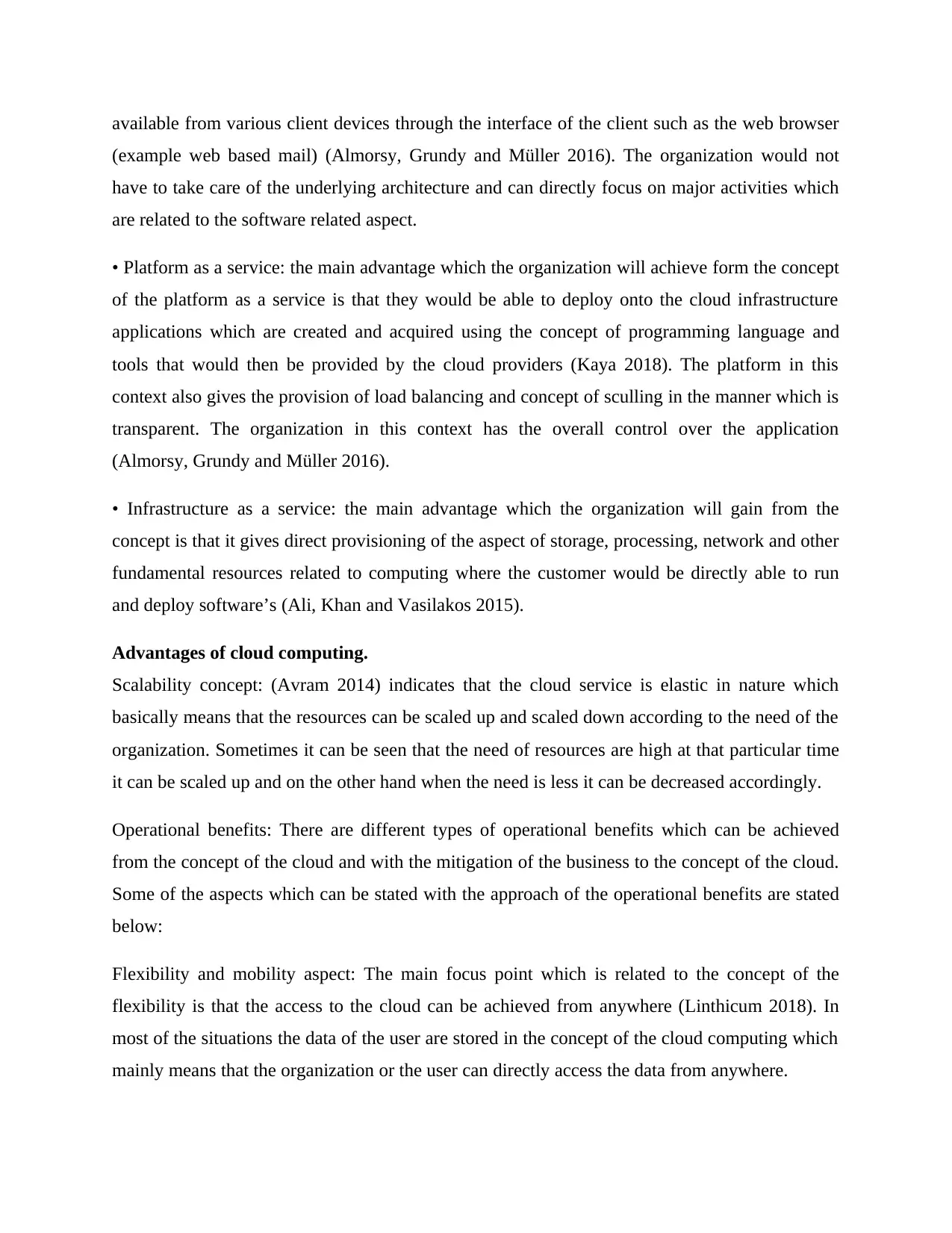
available from various client devices through the interface of the client such as the web browser
(example web based mail) (Almorsy, Grundy and Müller 2016). The organization would not
have to take care of the underlying architecture and can directly focus on major activities which
are related to the software related aspect.
• Platform as a service: the main advantage which the organization will achieve form the concept
of the platform as a service is that they would be able to deploy onto the cloud infrastructure
applications which are created and acquired using the concept of programming language and
tools that would then be provided by the cloud providers (Kaya 2018). The platform in this
context also gives the provision of load balancing and concept of sculling in the manner which is
transparent. The organization in this context has the overall control over the application
(Almorsy, Grundy and Müller 2016).
• Infrastructure as a service: the main advantage which the organization will gain from the
concept is that it gives direct provisioning of the aspect of storage, processing, network and other
fundamental resources related to computing where the customer would be directly able to run
and deploy software’s (Ali, Khan and Vasilakos 2015).
Advantages of cloud computing.
Scalability concept: (Avram 2014) indicates that the cloud service is elastic in nature which
basically means that the resources can be scaled up and scaled down according to the need of the
organization. Sometimes it can be seen that the need of resources are high at that particular time
it can be scaled up and on the other hand when the need is less it can be decreased accordingly.
Operational benefits: There are different types of operational benefits which can be achieved
from the concept of the cloud and with the mitigation of the business to the concept of the cloud.
Some of the aspects which can be stated with the approach of the operational benefits are stated
below:
Flexibility and mobility aspect: The main focus point which is related to the concept of the
flexibility is that the access to the cloud can be achieved from anywhere (Linthicum 2018). In
most of the situations the data of the user are stored in the concept of the cloud computing which
mainly means that the organization or the user can directly access the data from anywhere.
(example web based mail) (Almorsy, Grundy and Müller 2016). The organization would not
have to take care of the underlying architecture and can directly focus on major activities which
are related to the software related aspect.
• Platform as a service: the main advantage which the organization will achieve form the concept
of the platform as a service is that they would be able to deploy onto the cloud infrastructure
applications which are created and acquired using the concept of programming language and
tools that would then be provided by the cloud providers (Kaya 2018). The platform in this
context also gives the provision of load balancing and concept of sculling in the manner which is
transparent. The organization in this context has the overall control over the application
(Almorsy, Grundy and Müller 2016).
• Infrastructure as a service: the main advantage which the organization will gain from the
concept is that it gives direct provisioning of the aspect of storage, processing, network and other
fundamental resources related to computing where the customer would be directly able to run
and deploy software’s (Ali, Khan and Vasilakos 2015).
Advantages of cloud computing.
Scalability concept: (Avram 2014) indicates that the cloud service is elastic in nature which
basically means that the resources can be scaled up and scaled down according to the need of the
organization. Sometimes it can be seen that the need of resources are high at that particular time
it can be scaled up and on the other hand when the need is less it can be decreased accordingly.
Operational benefits: There are different types of operational benefits which can be achieved
from the concept of the cloud and with the mitigation of the business to the concept of the cloud.
Some of the aspects which can be stated with the approach of the operational benefits are stated
below:
Flexibility and mobility aspect: The main focus point which is related to the concept of the
flexibility is that the access to the cloud can be achieved from anywhere (Linthicum 2018). In
most of the situations the data of the user are stored in the concept of the cloud computing which
mainly means that the organization or the user can directly access the data from anywhere.
⊘ This is a preview!⊘
Do you want full access?
Subscribe today to unlock all pages.

Trusted by 1+ million students worldwide
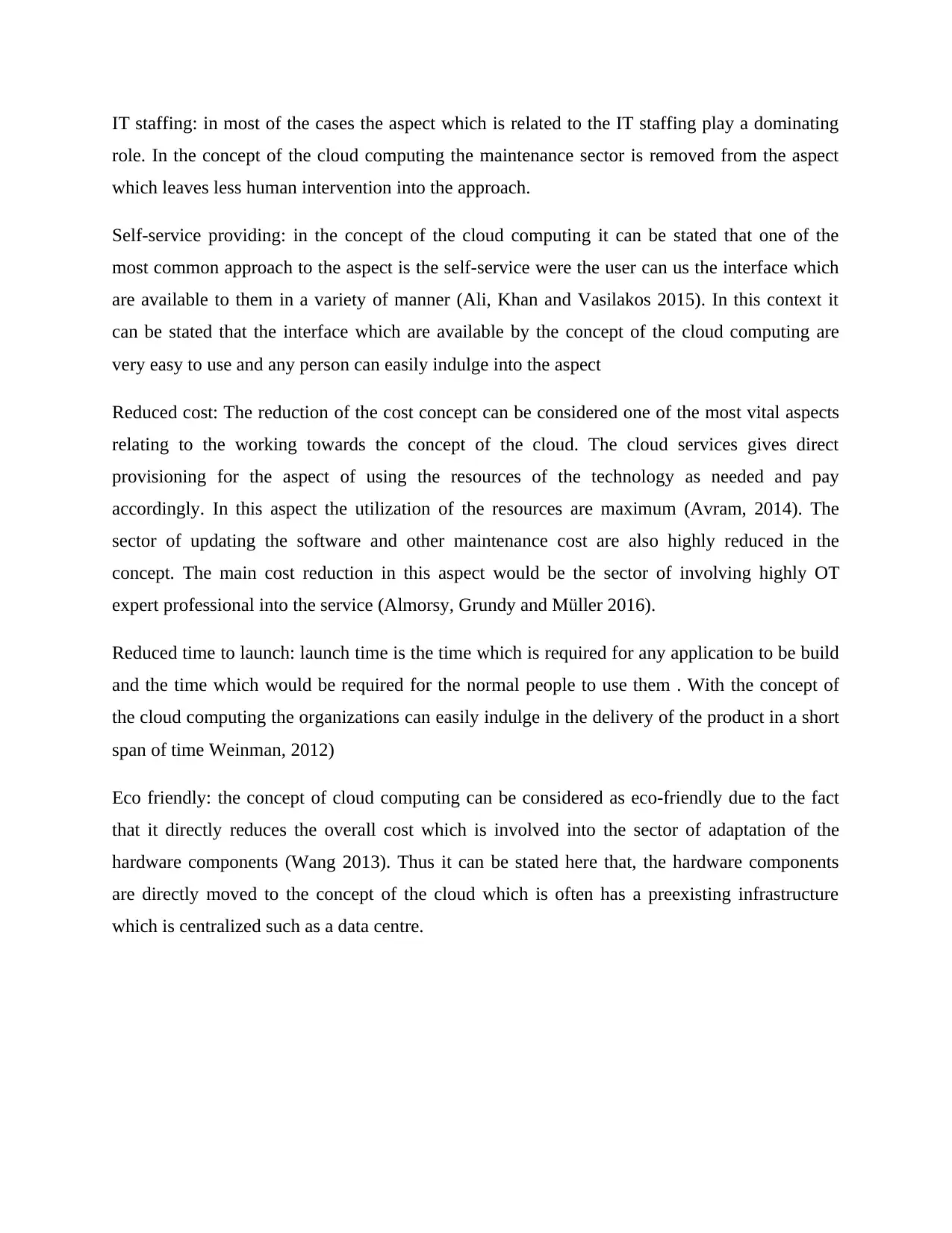
IT staffing: in most of the cases the aspect which is related to the IT staffing play a dominating
role. In the concept of the cloud computing the maintenance sector is removed from the aspect
which leaves less human intervention into the approach.
Self-service providing: in the concept of the cloud computing it can be stated that one of the
most common approach to the aspect is the self-service were the user can us the interface which
are available to them in a variety of manner (Ali, Khan and Vasilakos 2015). In this context it
can be stated that the interface which are available by the concept of the cloud computing are
very easy to use and any person can easily indulge into the aspect
Reduced cost: The reduction of the cost concept can be considered one of the most vital aspects
relating to the working towards the concept of the cloud. The cloud services gives direct
provisioning for the aspect of using the resources of the technology as needed and pay
accordingly. In this aspect the utilization of the resources are maximum (Avram, 2014). The
sector of updating the software and other maintenance cost are also highly reduced in the
concept. The main cost reduction in this aspect would be the sector of involving highly OT
expert professional into the service (Almorsy, Grundy and Müller 2016).
Reduced time to launch: launch time is the time which is required for any application to be build
and the time which would be required for the normal people to use them . With the concept of
the cloud computing the organizations can easily indulge in the delivery of the product in a short
span of time Weinman, 2012)
Eco friendly: the concept of cloud computing can be considered as eco-friendly due to the fact
that it directly reduces the overall cost which is involved into the sector of adaptation of the
hardware components (Wang 2013). Thus it can be stated here that, the hardware components
are directly moved to the concept of the cloud which is often has a preexisting infrastructure
which is centralized such as a data centre.
role. In the concept of the cloud computing the maintenance sector is removed from the aspect
which leaves less human intervention into the approach.
Self-service providing: in the concept of the cloud computing it can be stated that one of the
most common approach to the aspect is the self-service were the user can us the interface which
are available to them in a variety of manner (Ali, Khan and Vasilakos 2015). In this context it
can be stated that the interface which are available by the concept of the cloud computing are
very easy to use and any person can easily indulge into the aspect
Reduced cost: The reduction of the cost concept can be considered one of the most vital aspects
relating to the working towards the concept of the cloud. The cloud services gives direct
provisioning for the aspect of using the resources of the technology as needed and pay
accordingly. In this aspect the utilization of the resources are maximum (Avram, 2014). The
sector of updating the software and other maintenance cost are also highly reduced in the
concept. The main cost reduction in this aspect would be the sector of involving highly OT
expert professional into the service (Almorsy, Grundy and Müller 2016).
Reduced time to launch: launch time is the time which is required for any application to be build
and the time which would be required for the normal people to use them . With the concept of
the cloud computing the organizations can easily indulge in the delivery of the product in a short
span of time Weinman, 2012)
Eco friendly: the concept of cloud computing can be considered as eco-friendly due to the fact
that it directly reduces the overall cost which is involved into the sector of adaptation of the
hardware components (Wang 2013). Thus it can be stated here that, the hardware components
are directly moved to the concept of the cloud which is often has a preexisting infrastructure
which is centralized such as a data centre.
Paraphrase This Document
Need a fresh take? Get an instant paraphrase of this document with our AI Paraphraser
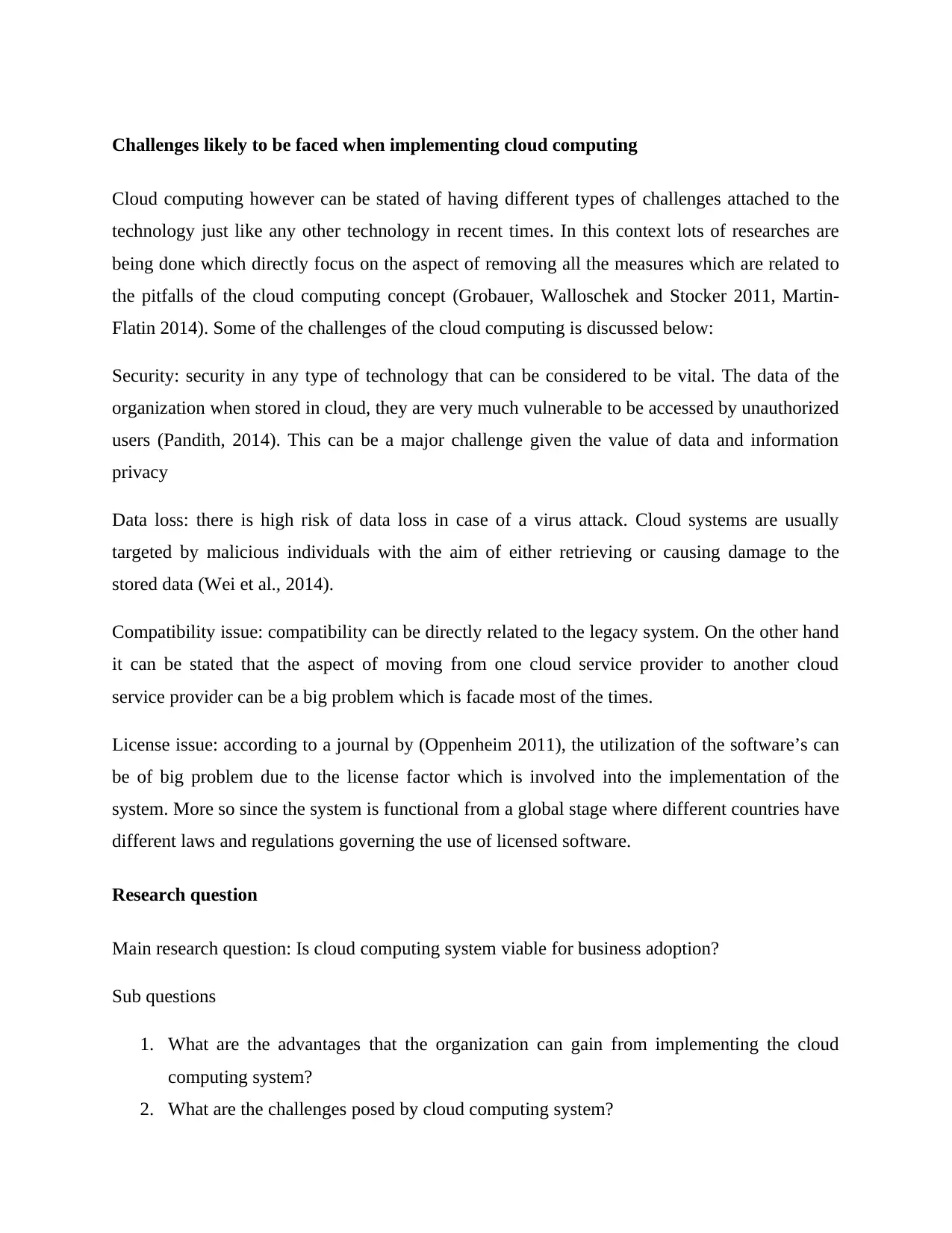
Challenges likely to be faced when implementing cloud computing
Cloud computing however can be stated of having different types of challenges attached to the
technology just like any other technology in recent times. In this context lots of researches are
being done which directly focus on the aspect of removing all the measures which are related to
the pitfalls of the cloud computing concept (Grobauer, Walloschek and Stocker 2011, Martin-
Flatin 2014). Some of the challenges of the cloud computing is discussed below:
Security: security in any type of technology that can be considered to be vital. The data of the
organization when stored in cloud, they are very much vulnerable to be accessed by unauthorized
users (Pandith, 2014). This can be a major challenge given the value of data and information
privacy
Data loss: there is high risk of data loss in case of a virus attack. Cloud systems are usually
targeted by malicious individuals with the aim of either retrieving or causing damage to the
stored data (Wei et al., 2014).
Compatibility issue: compatibility can be directly related to the legacy system. On the other hand
it can be stated that the aspect of moving from one cloud service provider to another cloud
service provider can be a big problem which is facade most of the times.
License issue: according to a journal by (Oppenheim 2011), the utilization of the software’s can
be of big problem due to the license factor which is involved into the implementation of the
system. More so since the system is functional from a global stage where different countries have
different laws and regulations governing the use of licensed software.
Research question
Main research question: Is cloud computing system viable for business adoption?
Sub questions
1. What are the advantages that the organization can gain from implementing the cloud
computing system?
2. What are the challenges posed by cloud computing system?
Cloud computing however can be stated of having different types of challenges attached to the
technology just like any other technology in recent times. In this context lots of researches are
being done which directly focus on the aspect of removing all the measures which are related to
the pitfalls of the cloud computing concept (Grobauer, Walloschek and Stocker 2011, Martin-
Flatin 2014). Some of the challenges of the cloud computing is discussed below:
Security: security in any type of technology that can be considered to be vital. The data of the
organization when stored in cloud, they are very much vulnerable to be accessed by unauthorized
users (Pandith, 2014). This can be a major challenge given the value of data and information
privacy
Data loss: there is high risk of data loss in case of a virus attack. Cloud systems are usually
targeted by malicious individuals with the aim of either retrieving or causing damage to the
stored data (Wei et al., 2014).
Compatibility issue: compatibility can be directly related to the legacy system. On the other hand
it can be stated that the aspect of moving from one cloud service provider to another cloud
service provider can be a big problem which is facade most of the times.
License issue: according to a journal by (Oppenheim 2011), the utilization of the software’s can
be of big problem due to the license factor which is involved into the implementation of the
system. More so since the system is functional from a global stage where different countries have
different laws and regulations governing the use of licensed software.
Research question
Main research question: Is cloud computing system viable for business adoption?
Sub questions
1. What are the advantages that the organization can gain from implementing the cloud
computing system?
2. What are the challenges posed by cloud computing system?
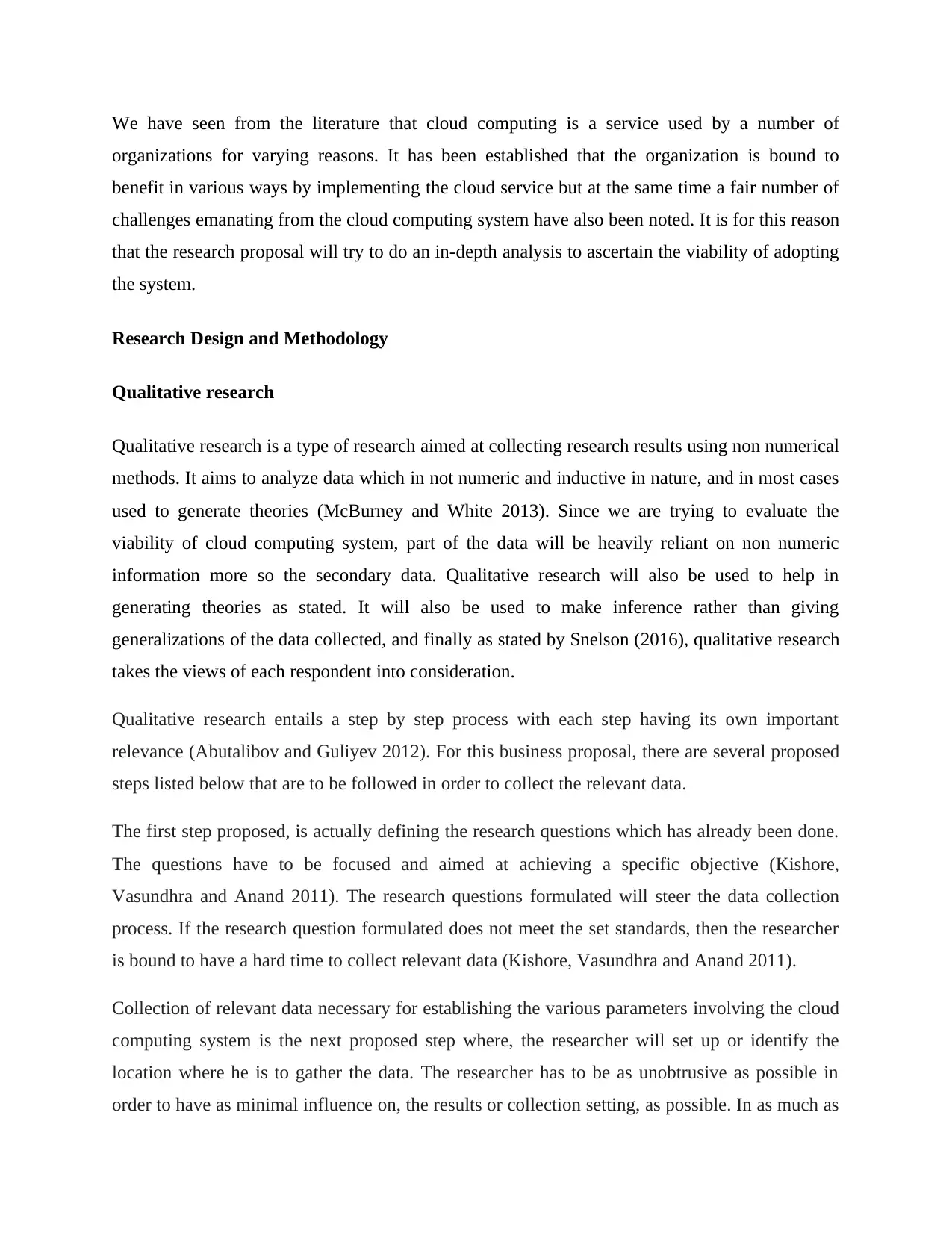
We have seen from the literature that cloud computing is a service used by a number of
organizations for varying reasons. It has been established that the organization is bound to
benefit in various ways by implementing the cloud service but at the same time a fair number of
challenges emanating from the cloud computing system have also been noted. It is for this reason
that the research proposal will try to do an in-depth analysis to ascertain the viability of adopting
the system.
Research Design and Methodology
Qualitative research
Qualitative research is a type of research aimed at collecting research results using non numerical
methods. It aims to analyze data which in not numeric and inductive in nature, and in most cases
used to generate theories (McBurney and White 2013). Since we are trying to evaluate the
viability of cloud computing system, part of the data will be heavily reliant on non numeric
information more so the secondary data. Qualitative research will also be used to help in
generating theories as stated. It will also be used to make inference rather than giving
generalizations of the data collected, and finally as stated by Snelson (2016), qualitative research
takes the views of each respondent into consideration.
Qualitative research entails a step by step process with each step having its own important
relevance (Abutalibov and Guliyev 2012). For this business proposal, there are several proposed
steps listed below that are to be followed in order to collect the relevant data.
The first step proposed, is actually defining the research questions which has already been done.
The questions have to be focused and aimed at achieving a specific objective (Kishore,
Vasundhra and Anand 2011). The research questions formulated will steer the data collection
process. If the research question formulated does not meet the set standards, then the researcher
is bound to have a hard time to collect relevant data (Kishore, Vasundhra and Anand 2011).
Collection of relevant data necessary for establishing the various parameters involving the cloud
computing system is the next proposed step where, the researcher will set up or identify the
location where he is to gather the data. The researcher has to be as unobtrusive as possible in
order to have as minimal influence on, the results or collection setting, as possible. In as much as
organizations for varying reasons. It has been established that the organization is bound to
benefit in various ways by implementing the cloud service but at the same time a fair number of
challenges emanating from the cloud computing system have also been noted. It is for this reason
that the research proposal will try to do an in-depth analysis to ascertain the viability of adopting
the system.
Research Design and Methodology
Qualitative research
Qualitative research is a type of research aimed at collecting research results using non numerical
methods. It aims to analyze data which in not numeric and inductive in nature, and in most cases
used to generate theories (McBurney and White 2013). Since we are trying to evaluate the
viability of cloud computing system, part of the data will be heavily reliant on non numeric
information more so the secondary data. Qualitative research will also be used to help in
generating theories as stated. It will also be used to make inference rather than giving
generalizations of the data collected, and finally as stated by Snelson (2016), qualitative research
takes the views of each respondent into consideration.
Qualitative research entails a step by step process with each step having its own important
relevance (Abutalibov and Guliyev 2012). For this business proposal, there are several proposed
steps listed below that are to be followed in order to collect the relevant data.
The first step proposed, is actually defining the research questions which has already been done.
The questions have to be focused and aimed at achieving a specific objective (Kishore,
Vasundhra and Anand 2011). The research questions formulated will steer the data collection
process. If the research question formulated does not meet the set standards, then the researcher
is bound to have a hard time to collect relevant data (Kishore, Vasundhra and Anand 2011).
Collection of relevant data necessary for establishing the various parameters involving the cloud
computing system is the next proposed step where, the researcher will set up or identify the
location where he is to gather the data. The researcher has to be as unobtrusive as possible in
order to have as minimal influence on, the results or collection setting, as possible. In as much as
⊘ This is a preview!⊘
Do you want full access?
Subscribe today to unlock all pages.

Trusted by 1+ million students worldwide
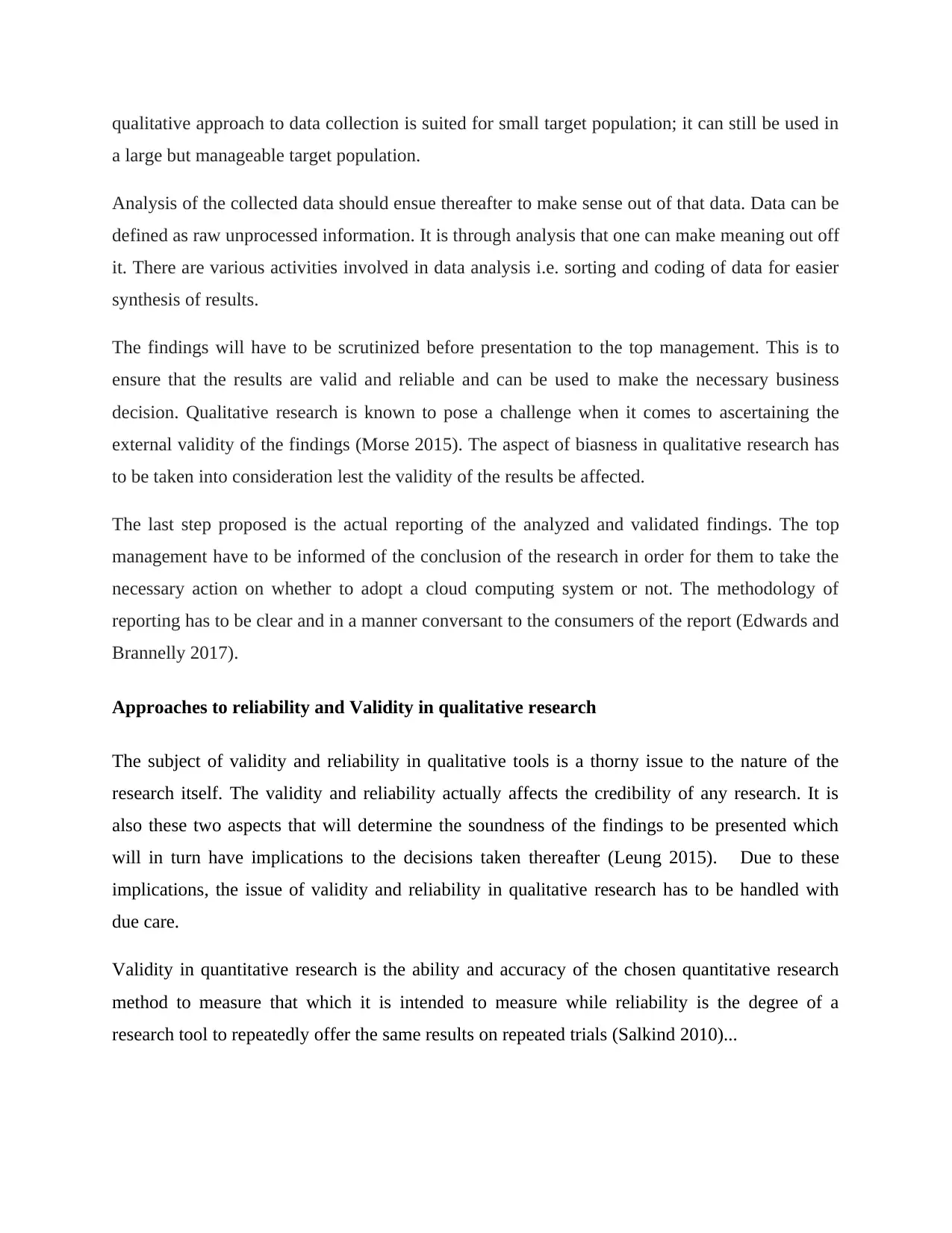
qualitative approach to data collection is suited for small target population; it can still be used in
a large but manageable target population.
Analysis of the collected data should ensue thereafter to make sense out of that data. Data can be
defined as raw unprocessed information. It is through analysis that one can make meaning out off
it. There are various activities involved in data analysis i.e. sorting and coding of data for easier
synthesis of results.
The findings will have to be scrutinized before presentation to the top management. This is to
ensure that the results are valid and reliable and can be used to make the necessary business
decision. Qualitative research is known to pose a challenge when it comes to ascertaining the
external validity of the findings (Morse 2015). The aspect of biasness in qualitative research has
to be taken into consideration lest the validity of the results be affected.
The last step proposed is the actual reporting of the analyzed and validated findings. The top
management have to be informed of the conclusion of the research in order for them to take the
necessary action on whether to adopt a cloud computing system or not. The methodology of
reporting has to be clear and in a manner conversant to the consumers of the report (Edwards and
Brannelly 2017).
Approaches to reliability and Validity in qualitative research
The subject of validity and reliability in qualitative tools is a thorny issue to the nature of the
research itself. The validity and reliability actually affects the credibility of any research. It is
also these two aspects that will determine the soundness of the findings to be presented which
will in turn have implications to the decisions taken thereafter (Leung 2015). Due to these
implications, the issue of validity and reliability in qualitative research has to be handled with
due care.
Validity in quantitative research is the ability and accuracy of the chosen quantitative research
method to measure that which it is intended to measure while reliability is the degree of a
research tool to repeatedly offer the same results on repeated trials (Salkind 2010)...
a large but manageable target population.
Analysis of the collected data should ensue thereafter to make sense out of that data. Data can be
defined as raw unprocessed information. It is through analysis that one can make meaning out off
it. There are various activities involved in data analysis i.e. sorting and coding of data for easier
synthesis of results.
The findings will have to be scrutinized before presentation to the top management. This is to
ensure that the results are valid and reliable and can be used to make the necessary business
decision. Qualitative research is known to pose a challenge when it comes to ascertaining the
external validity of the findings (Morse 2015). The aspect of biasness in qualitative research has
to be taken into consideration lest the validity of the results be affected.
The last step proposed is the actual reporting of the analyzed and validated findings. The top
management have to be informed of the conclusion of the research in order for them to take the
necessary action on whether to adopt a cloud computing system or not. The methodology of
reporting has to be clear and in a manner conversant to the consumers of the report (Edwards and
Brannelly 2017).
Approaches to reliability and Validity in qualitative research
The subject of validity and reliability in qualitative tools is a thorny issue to the nature of the
research itself. The validity and reliability actually affects the credibility of any research. It is
also these two aspects that will determine the soundness of the findings to be presented which
will in turn have implications to the decisions taken thereafter (Leung 2015). Due to these
implications, the issue of validity and reliability in qualitative research has to be handled with
due care.
Validity in quantitative research is the ability and accuracy of the chosen quantitative research
method to measure that which it is intended to measure while reliability is the degree of a
research tool to repeatedly offer the same results on repeated trials (Salkind 2010)...
Paraphrase This Document
Need a fresh take? Get an instant paraphrase of this document with our AI Paraphraser
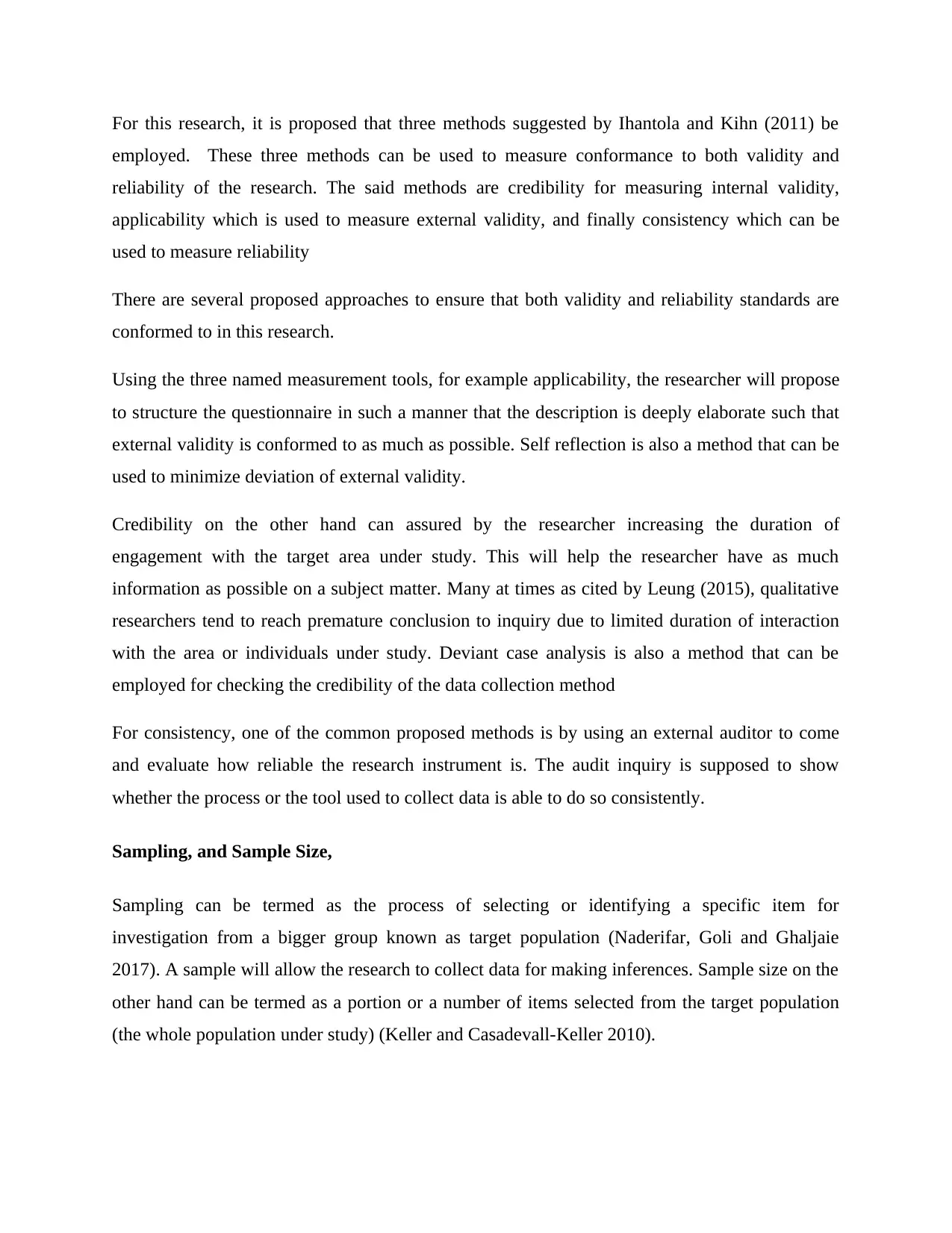
For this research, it is proposed that three methods suggested by Ihantola and Kihn (2011) be
employed. These three methods can be used to measure conformance to both validity and
reliability of the research. The said methods are credibility for measuring internal validity,
applicability which is used to measure external validity, and finally consistency which can be
used to measure reliability
There are several proposed approaches to ensure that both validity and reliability standards are
conformed to in this research.
Using the three named measurement tools, for example applicability, the researcher will propose
to structure the questionnaire in such a manner that the description is deeply elaborate such that
external validity is conformed to as much as possible. Self reflection is also a method that can be
used to minimize deviation of external validity.
Credibility on the other hand can assured by the researcher increasing the duration of
engagement with the target area under study. This will help the researcher have as much
information as possible on a subject matter. Many at times as cited by Leung (2015), qualitative
researchers tend to reach premature conclusion to inquiry due to limited duration of interaction
with the area or individuals under study. Deviant case analysis is also a method that can be
employed for checking the credibility of the data collection method
For consistency, one of the common proposed methods is by using an external auditor to come
and evaluate how reliable the research instrument is. The audit inquiry is supposed to show
whether the process or the tool used to collect data is able to do so consistently.
Sampling, and Sample Size,
Sampling can be termed as the process of selecting or identifying a specific item for
investigation from a bigger group known as target population (Naderifar, Goli and Ghaljaie
2017). A sample will allow the research to collect data for making inferences. Sample size on the
other hand can be termed as a portion or a number of items selected from the target population
(the whole population under study) (Keller and Casadevall-Keller 2010).
employed. These three methods can be used to measure conformance to both validity and
reliability of the research. The said methods are credibility for measuring internal validity,
applicability which is used to measure external validity, and finally consistency which can be
used to measure reliability
There are several proposed approaches to ensure that both validity and reliability standards are
conformed to in this research.
Using the three named measurement tools, for example applicability, the researcher will propose
to structure the questionnaire in such a manner that the description is deeply elaborate such that
external validity is conformed to as much as possible. Self reflection is also a method that can be
used to minimize deviation of external validity.
Credibility on the other hand can assured by the researcher increasing the duration of
engagement with the target area under study. This will help the researcher have as much
information as possible on a subject matter. Many at times as cited by Leung (2015), qualitative
researchers tend to reach premature conclusion to inquiry due to limited duration of interaction
with the area or individuals under study. Deviant case analysis is also a method that can be
employed for checking the credibility of the data collection method
For consistency, one of the common proposed methods is by using an external auditor to come
and evaluate how reliable the research instrument is. The audit inquiry is supposed to show
whether the process or the tool used to collect data is able to do so consistently.
Sampling, and Sample Size,
Sampling can be termed as the process of selecting or identifying a specific item for
investigation from a bigger group known as target population (Naderifar, Goli and Ghaljaie
2017). A sample will allow the research to collect data for making inferences. Sample size on the
other hand can be termed as a portion or a number of items selected from the target population
(the whole population under study) (Keller and Casadevall-Keller 2010).
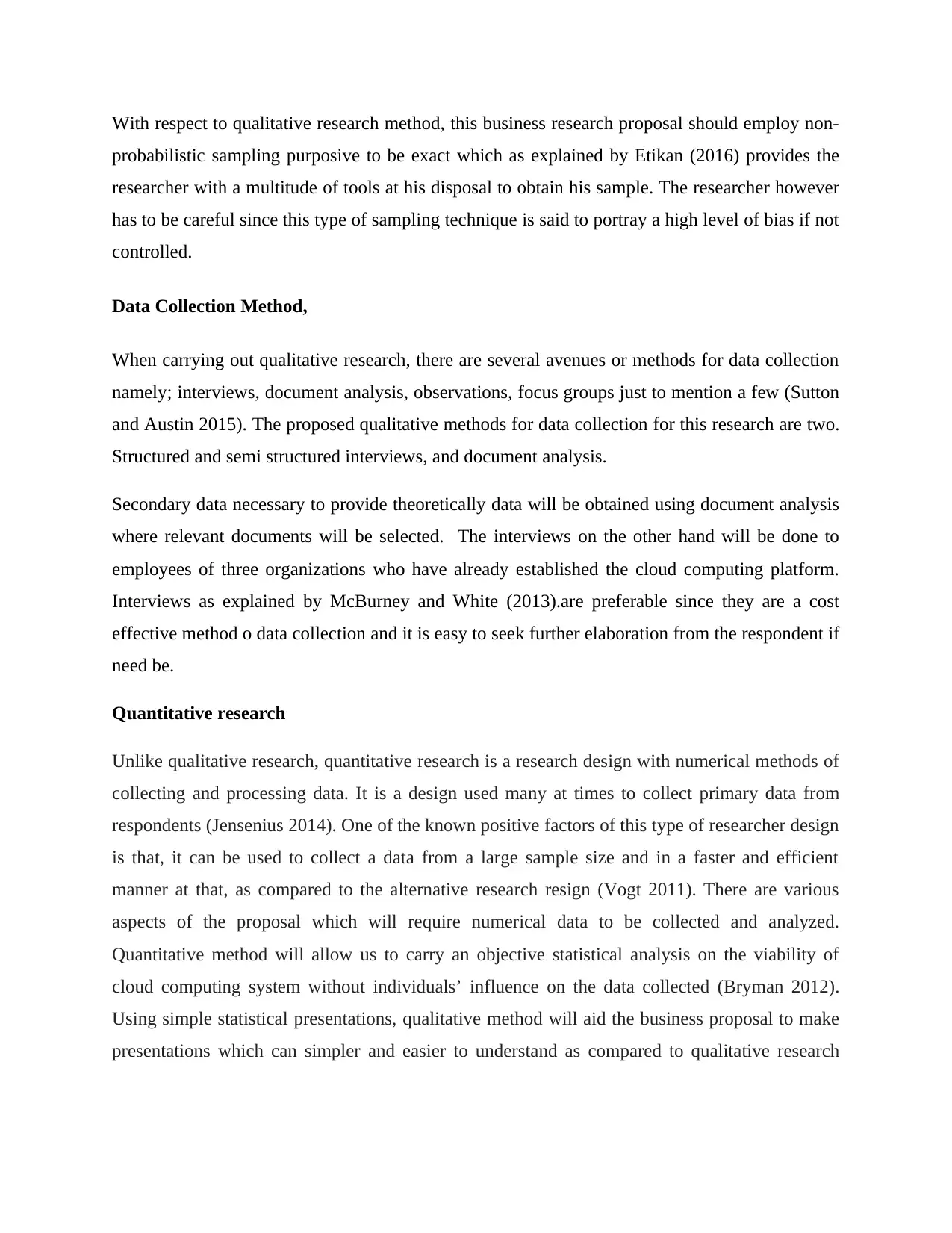
With respect to qualitative research method, this business research proposal should employ non-
probabilistic sampling purposive to be exact which as explained by Etikan (2016) provides the
researcher with a multitude of tools at his disposal to obtain his sample. The researcher however
has to be careful since this type of sampling technique is said to portray a high level of bias if not
controlled.
Data Collection Method,
When carrying out qualitative research, there are several avenues or methods for data collection
namely; interviews, document analysis, observations, focus groups just to mention a few (Sutton
and Austin 2015). The proposed qualitative methods for data collection for this research are two.
Structured and semi structured interviews, and document analysis.
Secondary data necessary to provide theoretically data will be obtained using document analysis
where relevant documents will be selected. The interviews on the other hand will be done to
employees of three organizations who have already established the cloud computing platform.
Interviews as explained by McBurney and White (2013).are preferable since they are a cost
effective method o data collection and it is easy to seek further elaboration from the respondent if
need be.
Quantitative research
Unlike qualitative research, quantitative research is a research design with numerical methods of
collecting and processing data. It is a design used many at times to collect primary data from
respondents (Jensenius 2014). One of the known positive factors of this type of researcher design
is that, it can be used to collect a data from a large sample size and in a faster and efficient
manner at that, as compared to the alternative research resign (Vogt 2011). There are various
aspects of the proposal which will require numerical data to be collected and analyzed.
Quantitative method will allow us to carry an objective statistical analysis on the viability of
cloud computing system without individuals’ influence on the data collected (Bryman 2012).
Using simple statistical presentations, qualitative method will aid the business proposal to make
presentations which can simpler and easier to understand as compared to qualitative research
probabilistic sampling purposive to be exact which as explained by Etikan (2016) provides the
researcher with a multitude of tools at his disposal to obtain his sample. The researcher however
has to be careful since this type of sampling technique is said to portray a high level of bias if not
controlled.
Data Collection Method,
When carrying out qualitative research, there are several avenues or methods for data collection
namely; interviews, document analysis, observations, focus groups just to mention a few (Sutton
and Austin 2015). The proposed qualitative methods for data collection for this research are two.
Structured and semi structured interviews, and document analysis.
Secondary data necessary to provide theoretically data will be obtained using document analysis
where relevant documents will be selected. The interviews on the other hand will be done to
employees of three organizations who have already established the cloud computing platform.
Interviews as explained by McBurney and White (2013).are preferable since they are a cost
effective method o data collection and it is easy to seek further elaboration from the respondent if
need be.
Quantitative research
Unlike qualitative research, quantitative research is a research design with numerical methods of
collecting and processing data. It is a design used many at times to collect primary data from
respondents (Jensenius 2014). One of the known positive factors of this type of researcher design
is that, it can be used to collect a data from a large sample size and in a faster and efficient
manner at that, as compared to the alternative research resign (Vogt 2011). There are various
aspects of the proposal which will require numerical data to be collected and analyzed.
Quantitative method will allow us to carry an objective statistical analysis on the viability of
cloud computing system without individuals’ influence on the data collected (Bryman 2012).
Using simple statistical presentations, qualitative method will aid the business proposal to make
presentations which can simpler and easier to understand as compared to qualitative research
⊘ This is a preview!⊘
Do you want full access?
Subscribe today to unlock all pages.

Trusted by 1+ million students worldwide
1 out of 21
Related Documents
Your All-in-One AI-Powered Toolkit for Academic Success.
+13062052269
info@desklib.com
Available 24*7 on WhatsApp / Email
![[object Object]](/_next/static/media/star-bottom.7253800d.svg)
Unlock your academic potential
Copyright © 2020–2025 A2Z Services. All Rights Reserved. Developed and managed by ZUCOL.





